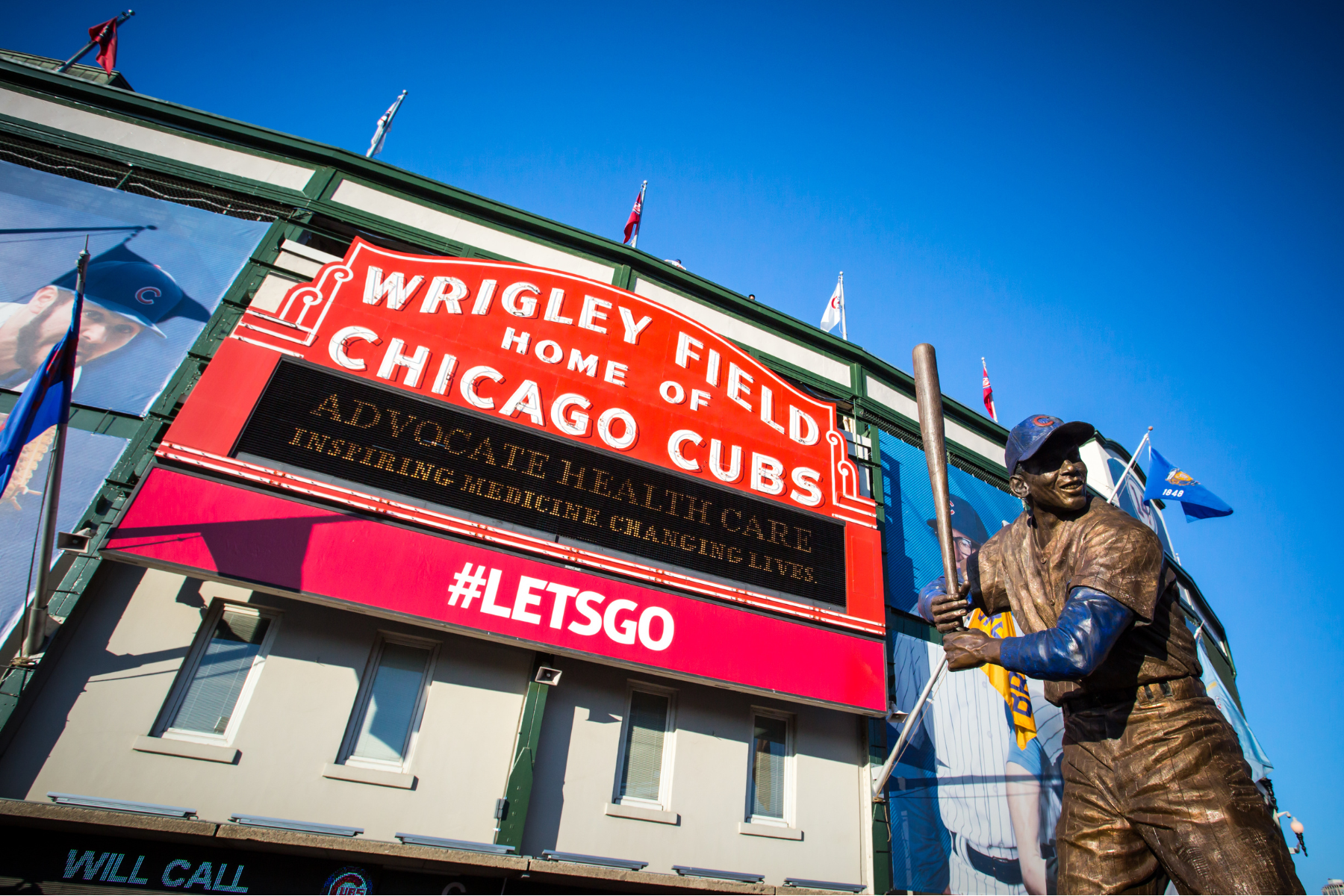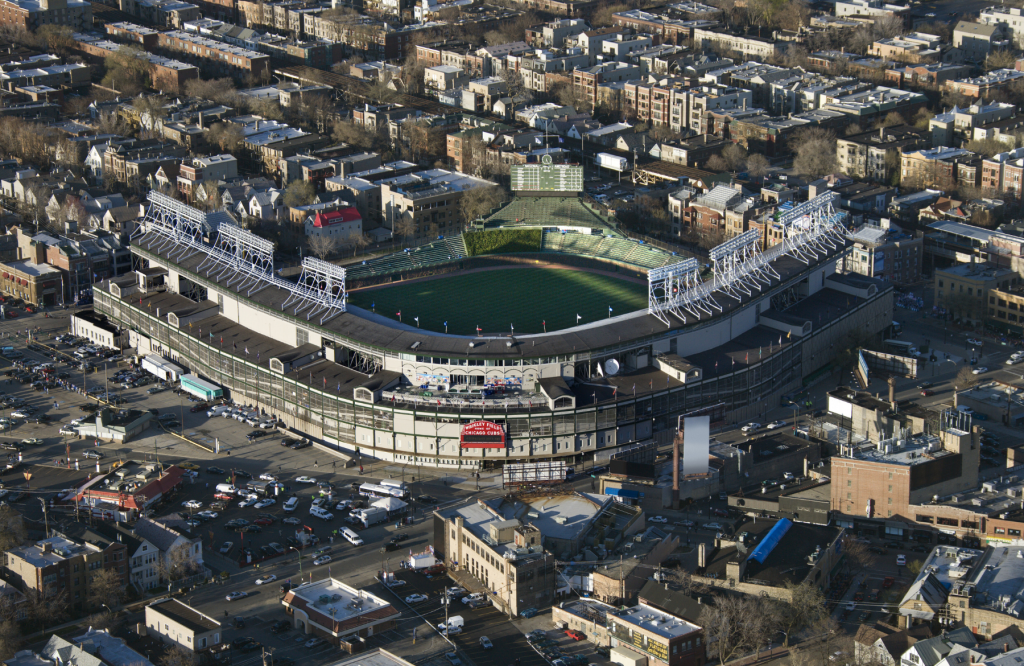
The History of Wrigley Field’s “Friendly Confines”
Published on September 29, 2023
Wrigley Field and Wrigleyville are part of Lakeview, where eATLAS has Katie Carol’s Coffee and Dessert Crawl through four shops on Broadway.
By Dave Lifton (@daveeatschicago)
Since 1916, the Chicago Cubs have called Wrigley Field at 1060 W. Addison St. in Lakeview home. The team is so closely associated with the North Side that it’s almost hard to fathom that they ever played anywhere else.
Founded as the Chicago White Stockings in 1869, they had a nomadic existence for their first 25 years, rarely spending more than three years at any one ballpark at locations downtown and on the South and West Sides. After the 1893 season, the Colts, as they were now known, settled down in a second West Side Park for the next 23 years.
Then, the Cubs were purchased by Albert Lasker and Charles Weeghman, who moved the team to Weeghman’s self-named 15,000-seat park on the North Side corner of Clark and Addison that he built two years prior to house his defunct Federal League team. But Weeghman soon needed money due to his other business interests and recruited several other men to join the Cubs’ ownership group, one of whom was chewing gum manufacturer William Wrigley.
By 1918, Wrigley bought out Weeghman and Weeghman Park became Cubs Park. Over the next few years, Wrigley began purchasing more of the team’s shares until he became the sole owner in 1921, the same year the Chicago Bears began playing at the stadium and stayed through the 1970 season.
Almost immediately, Wrigley set about expanding the stadium. The grandstand was expanded outward and the bleachers were improved. After the 1926 season, the park was renamed Wrigley Field, and construction began on building a second deck to the grandstand, which was completed in time for the 1928 opener. The capacity was now around 40,000, which is where it’s been—give or take a few thousand—ever since.
Wrigley died in 1932 and his son, Philip, inherited the team. His first few years in charge would see three of the stadium’s most iconic features put into place. The marquee at the main entrance was installed in 1934, although it wouldn’t take on its red color until 1960. Three years later the ivy was on the outfield wall and, as part of a renovation to the bleachers, a scoreboard in centerfield was erected.
Shortly thereafter, the Cubs began flying a W or L flag from the scoreboard to inform passengers coming home from work on the Northwestern Line (now Red Line) of the result of that afternoon’s game. More often than not, however, it was an L.
Philip Wrigley’s death in 1977 led to the team being sold to the Tribune Company in 1981. The Cubs still lost most of their games, but its ownership of WGN-TV, which broadcast the team, took them nationwide through cable television. With Harry Caray’s—let’s just say, “colorful”—approach to calling games and singing “Take Me Out to the Ballgame,” the Cubs became many people’s second-favorite team.

In an era marked by cookie-cutter behemoths, artificial turf, and domed stadia, baseball lovers made pilgrimages to Wrigleyville to see how the game had been played in a bygone era: A charming, red-brick-and-ivy ballpark with unpredictable wind patterns built before World War I, anchoring a neighborhood filled with bars and fans peering in from the rooftops. And the games were only played during the day.
The Tribune Company and Major League Baseball’s attempts to put lights in Wrigley was met with resistance from baseball purists and those who were afraid it would negatively affect Wrigleyville. Ordinances at the city and state levels were passed barring night games at the stadium, and the team unsuccessfully sued to have them lifted. Finally, in February 1988, a compromise was reached and, on Aug. 8, 1988, the first night game at Wrigley Field began. As if the gods themselves were protesting, the game was called in the bottom of the fourth inning due to rain.
The Ricketts family purchased the Cubs from the Tribune Company in 2009 and set about renovating Wrigley. This time, the pushback came from the city’s Landmarks Commission and the owners of the apartments across the streets, because the installation of giant video screens would obstruct the views from the rooftops.
Negotiations were completed in 2013 and construction began a year later. Over the next five years, Wrigley was modernized, with the biggest upgrades being video screens in right and left field, new clubhouses, and the parking lots on the west side of the building replaced by a new office building with retail spaces and a plaza.
In the midst of all this, the team managed to do the thing that had eluded them since 1908. On Nov. 2, 2016, the Cubs erased 108 years of heartbreak by beating Cleveland in Game 7 of the World Series. The game was played in Cleveland, but the scene outside Wrigley when the final out was made will never be forgotten by those who were there.
The Ricketts’ changes impacted Wrigleyville. Many of the old dive bars have been replaced by more upscale restaurants and hip clubs, some of which are in new buildings owned by the team. And there are those who prefer the way it had been. Still, as a stadium, Wrigley Field has retained much of its original vibe while providing a 21st century baseball experience.

The Adventure starts when you say it does.
All eATLAS Adventures are designed and built by experienced eATLAS Whoa!Guides. They're always on. Always entertaining. And always ready to go.
Check out our Adventures!